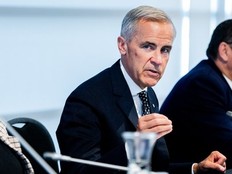CHARLEBOIS: Why food prices haven’t spiked due to tariffs — yet
Food inflation doesn’t follow a linear or predictable timetable

Article content
For months now, consumers across North America have been wondering: Where’s the inflation? With tariffs making headlines constantly — particularly under the Trump administration — many expected food prices to spike. Yet, grocery bills haven’t exploded. Not yet.
As John Rapley, a leading economist, and others recently explained, that calm may be misleading.
In Canada, food inflation in June came in at a moderate 2.8%, still well above the overall inflation rate of 1.9%, according to Statistics Canada. That gap underscores how food is still outpacing general inflation — but the divergence is narrowing, at least for now. Food inflation has eased from 3.8% earlier this year, but the rate of decline is slowing.
In the United States, the trend is even more pronounced. The U.S. Consumer Price Index rose 2.7% year-over-year in June, while food prices climbed by approximately 3%. Grocery store prices matched that rate, and restaurant meals rose even more sharply. Prices for beef, coffee and citrus saw month-over-month increases exceeding 2%, showing clear signs of price pressure.
There’s a dangerous assumption circulating in public discourse: If tariffs haven’t already translated into higher prices, they probably won’t. But food inflation doesn’t follow a linear or predictable timetable. In fact, the current lull may signal something more troubling — a delayed blow to household budgets that could hit when consumers are least prepared.
Donald Trump famously told Walmart a few months ago to “eat up tariffs,” arguing that a giant like Walmart can absorb costs — until it can’t. Rising input and inventory costs will eventually make their way up the food chain.
When tariffs are announced, importers often rush to stockpile goods before the new duties apply. In the food sector, that means filling warehouses with tariff-free inventory — cheaper ingredients, packaging, even finished products. Retailers also hesitate to raise prices immediately, opting instead to absorb short-term costs to stay competitive, banking on smoother negotiations or more favourable media coverage.
But those buffers don’t last forever. Eventually, the warehouse shelves are emptied, and what replaces them is significantly more expensive.
When that transition happens, price increases aren’t gradual — they’re abrupt. A $4.99 product suddenly becomes $5.69. It’s subtle, but it’s real. These step changes chip away at consumer trust and spark frustration, often directed at grocers, suppliers or policymakers.
These numbers may not seem alarming in isolation — but they highlight a persistent gap between general inflation and the cost of feeding a family. And many retailers are still relying on pre-tariff inventories. That cushion is vanishing.
RECOMMENDED VIDEO
Then there’s the “uncertainty tax.” With Donald Trump’s unpredictable Truth Social posts and erratic trade rhetoric, many food companies are preemptively pricing in the risk of higher tariffs to protect margins. Ironically, this ends up costing consumers more. In many ways, it’s less damaging to know tariffs will be high than to be left in the dark.
This type of inflation — delayed, compressed, and poorly understood — is especially difficult for central banks to manage. It’s not driven by overheated demand but by distorted supply chains. Interest rate hikes won’t reverse trade disruptions. But if consumer expectations shift — if people begin to panic-buy or demand higher wages — the inflationary cycle becomes self-perpetuating.
In Canada, the stakes may be even higher. Our food system depends heavily on imported inputs — fertilizers, animal feed, specialty ingredients, packaging—and we are directly exposed to the consequences of U.S. trade policy. If Washington tightens tariffs on China or Mexico, the cost shock will ripple through Canadian supply chains, often without warning.
So far, Canada’s food inflation has moderated — and that’s welcome news. But policymakers should be cautious about claiming victory. The lagging effects of tariffs — and the misplaced sense of security they create — risk lulling consumers and officials into complacency.
In economics, timing is everything. And in food, timing can mean the difference between affordability and anxiety.
— Dr. Sylvain Charlebois is the Director of the Agri-Food Analytics Lab at Dalhousie University and co-host of The Food Professor Podcast. He is currently a visiting scholar at McGill University in Montreal.











Postmedia is committed to maintaining a lively but civil forum for discussion. Please keep comments relevant and respectful. Comments may take up to an hour to appear on the site. You will receive an email if there is a reply to your comment, an update to a thread you follow or if a user you follow comments. Visit our Community Guidelines for more information.